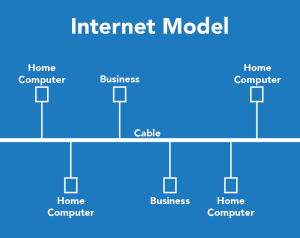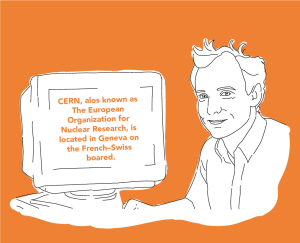1
Learning Objectives
- The difference between the web and the Internet
- The history of the web and how it has changed from its initial conception
Key Messages
- The web began as an open platform built on egalitarian principles with the purpose to further science and democracy
The Web ≠ The Internet
If someone asked you to describe “the web”, where would you start? How about describing “the internet”? What about if you were asked to describe what the difference between them was—do you think you’d be able to succinctly explain why and how they differ? If not, you’re not alone.
To begin, the web and the internet are two separate technologies often discussed simultaneously, but with very different qualities and histories.
First, let’s take a look at the internet. The internet is a decentralized global system of interconnected networks much like telephone or cellular networks. It is the system to which networks of computers can connect and talk to other networks of computers (a network of networks if you will). Created during the Cold War era of the late 1960s by the US defense department’s research arm known as the Advanced Research Projects Agency (or Arpa, later remained Darpa), the internet (then called ARPANnet) was designed as a military venture to connect government departments, defence contractors, and later universities, together. During the height of the Cold war, the USA feared a Soviet nuclear attack would destroy their only form of long-distance communication, telephone lines. In the event of an attack they’d be left isolated and unable to share information with each other, let alone the outside world. The burgeoning new technology found in computers was a way US intelligence agencies could send packets of data through a secure network that would be resilient to attack, thus the proto-internet was born. By the 1980s the Cold War was winding down and the ARPAnet shifted away from military use towards public research (under the National Science Foundation Network), linking universities and research teams together from across the globe. By 1990 ARPAnet was decommissioned and the internet as we know it began to take shape.

Just as the internet was coming into being in the late 1980s, the World Wide Web was being conceived in CERN by computer scientist Tim Berners-Lee. By 1990 the first web pages were created, and by ’91 people outside of CERN were invited to use the new technology. Under Berners-Lee’s advocacy, the web was made freely available allowing for a wave of mass collaboration and creativity to take place. This early web was built upon the democratic ideas of decentralized power, non-discrimination (also known as Net Neutrality), universality, and consensus. Unlike the press and other media which is owned and operated by large companies, the web (and its users) were accessible to anyone with a computer. This universal platform of equality and open structure allowed for unbridled growth in both communication and commerce to occur, allowing individuals to connect like never before.
Now that we know a little about the history of the internet and the web, we can see how they differ. Unlike the internet which is a global network (an infrastructure), the web is a collection of information (like a service) that is accessed via the internet. More simply put, the Web uses the internet as its foundational building blocks.

In the words of Tim Berners-Lee, the difference between the internet and the Web is as follows:
The Internet
“The Internet (‘Net) is a network of networks. Basically it is made from computers and cables. What Vint Cerf and Bob Kahn did was to figure out how this could be used to send around little “packets” of information. As Vint points out, a packet is a bit like a postcard with a simple address on it. If you put the right address on a packet, and gave it to any computer which is connected as part of the Net, each computer would figure out which cable to send it down next so that it would get to its destination. That’s what the Internet does. It delivers packets—anywhere in the world, normally well under a second.”
The Web
“The Web is an abstract (imaginary) space of information. On the Net, you find computers —on the Web, you find document, sounds, videos,…. information. On the Net, the connections are cables between computers; on the Web, connections are hypertext links. The Web exists because of programs which communicate between computers on the Net. The Web could not be without the Net. The Web made the net useful because people are really interested in information (not to mention knowledge!) and don’t really want to have know about computers and cables.”
Now that we know what the web and the internet are and how they fundamental differ, we can explore what they are, how they are used, and our relationship to them in greater detail.
Question
- Gopnik describes three classes of people: the Never-Betters, the Better-Nevers, and the Ever-Wasers. Which are you? Where are we as a society? Or is there a different category you and we belong in?
Readings
- Gopnik, Adam. 2011. The Information: How the Internet gets inside us. The New Yorker.
- Crash Course on the Web. 2017. PBS.
Media Attributions
- internet
- tbl
